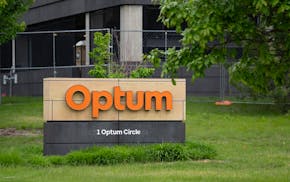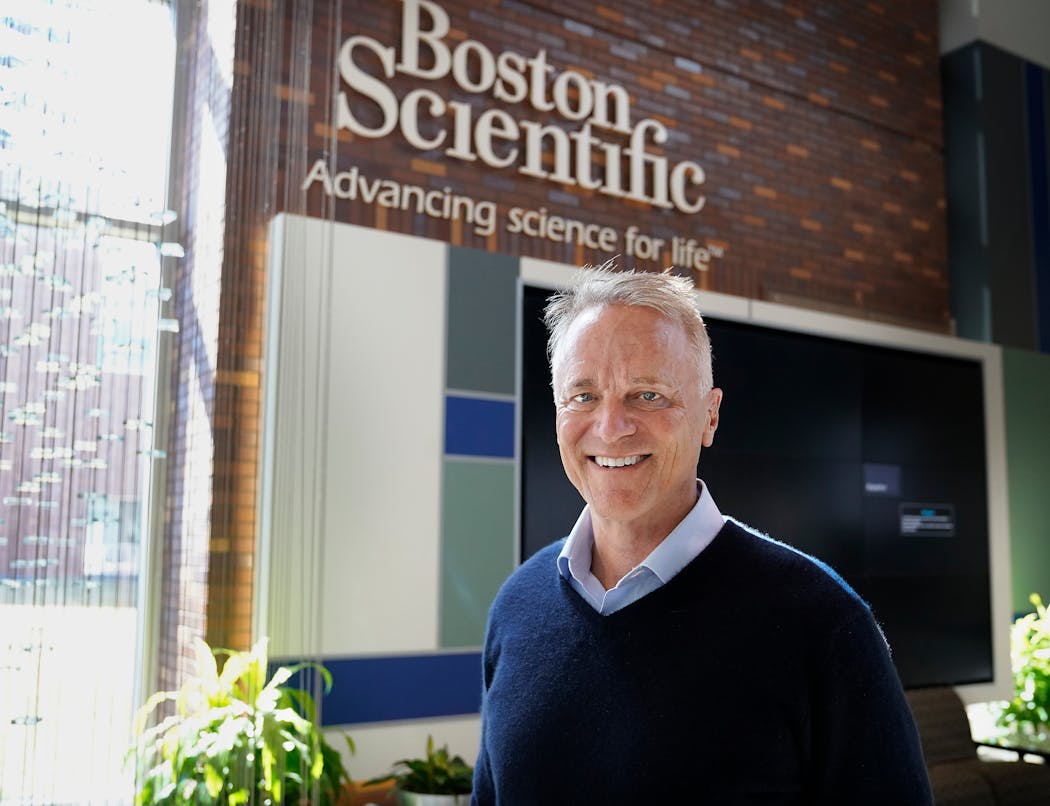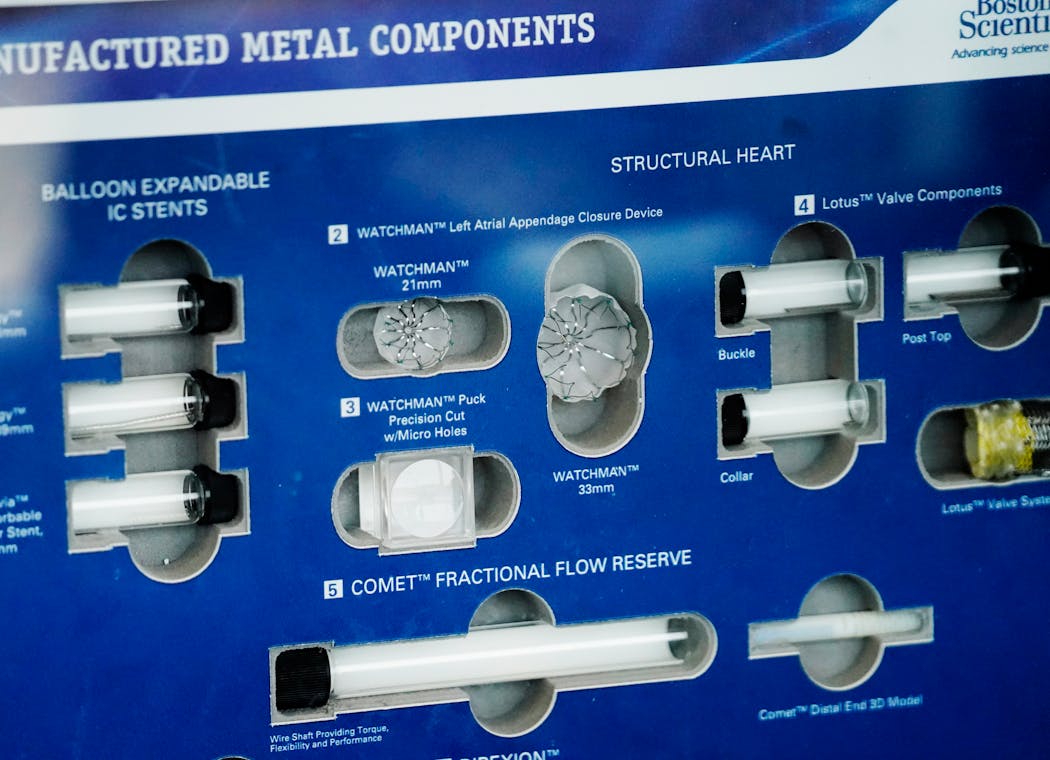Boston Scientific is betting big on Minnesota — with operations in the north metro suburbs helping shape the company's strategy for growth.
Take the Watchman, which was developed and is largely made here. Sales for the cardiac device grew 24% last year. They are expected to grow another 25% this year.
Mike Mahoney, the company's chief executive, said it's this kind of product that Boston Scientific wants to emphasize.
"Our businesses in the slower growth markets continue to get smaller and smaller as a percentage of sales, and we continue to layer on faster-growth markets and better innovation that also help us with pricing," he said during the company's first quarter conference call last month.
The Watchman's promise is a driving force behind the most recent expansion of the company's sprawling 79-acre Maple Grove campus. More than a decade ago, scientists here developed the device designed to reduce risk of stroke for patients with atrial fibrillation and get them off blood thinners.
"This whole campus has really ballooned over the last five to six years. We've added a number of jobs to this campus. It's easily doubled since I've been with the company," said Mahoney while visiting the campus last month.
Boston Scientific, based in Massachusetts, has 8,700 of its 45,000 employees in Minnesota, making it is one of the state's top 20 employers. Mahoney said the company has been growing its employee base by an average of 3% to 5% annually.
"It's where we have the most employees in the world," said Mahoney, a Chicago native and University of Iowa graduate who joined Boston Scientific in 2011 and became CEO in 2012.
Five of Boston Scientific's businesses are based in the state: interventional cardiology, peripheral interventions, cardiac rhythm management, interventional oncology and electrophysiology.
The company completed a new 78,000-square-foot fully electric, carbon-neutral building on the Maple Grove campus last fall. The facility, like the other manufacturing facilities on the campus, is humming 24 hours a day as workers make the Watchman components and other devices.
The Watchman device was originally developed by Plymouth-based Atritech Inc., which Boston Scientific acquired for $100 million in 2011. At the time of the deal the device was still in clinical trials. Boston Scientific secured U.S. Food and Drug Administration approval for Watchman in 2015.
The Watchman device alone had sales of $1 billion for 2022, accounting for 8% of its overall revenue of $12.7 billion.
"Watchman is one of our most important products. Atrial fibrillation is such a prevalent disease," Mahoney said.
The average Watchman device costs $16,000, according to data from PriceTrack, which includes pricing analysis for U.S. hospitals, from London-based information services provider Clarivate.
The third-generation Watchman is expected next year, Mahoney said on the earnings call, and continued clinical trials could expand usage as well. The company estimates that possibly only 10% of the market for Watchman is penetrated.
The company increased its revenue guidance last month from 5% to 7% growth this year to 8.5% to 10.5% in part because of continued growth of products like the Watchman.
Acquisitions such as Atritech that date to the 1990s are responsible for Boston Scientific's footprint in Minnesota and continue to help define it.
For example, the company was an investor in Maple Grove's NxThera and then in 2018 acquired it for $306 million. NxThera developed Rezum, a water vapor treatment for enlarged prostate.
"That is doing quite well internationally," said Mahoney of Rezum, which is now available in 65 countries.
Med-tech veteran Bob Paulson, CEO of NxThera when it was sold, said Boston Scientific chooses its targets carefully when backing a startup company.
"Boston [Scientific] doesn't make an equity investment unless there's a strategic interest at the business unit level," said Paulson, now CEO of Eagan-based Sonex Health.
Indeed, Chief Financial Officer Dan Brennan said during the last conference call that the company's first priority in capital spending is "high-quality tuck-in" acquisition activity that complement high-growth areas of Boston Scientific.
Future acquisitions of more Minnesota-based companies are likely given Boston Scientific's current venture portfolio.
"We have about 40 investments in our venture fund. There are a few that are in Minnesota today," said Mahoney.
Mahoney said about half of Boston Scientific's acquisitions are companies in which the company already holds an investment stake.
One of the company's 2021 acquisitions was Preventice Solutions Inc. in Eagan, which made mobile heart monitors including BodyGuardian. Boston Scientific has been an investor since 2015 and owned 22% of the company when it acquired Preventice for $925 million.
Boston Scientific first came to Minnesota when it bought Maple Grove-based SciMed Life Systems for $865 million in 1995. SciMed's angioplasty catheters became a growth engine.
Boston Scientific acquired Guidant Corp. for $27.2 billion after a bidding war with Johnson & Johnson in 2006. Guidant was based in Indianapolis but its cardiac rhythm management business was in Arden Hills.
Worldwide sales continue to grow. The company saw a 12% gain in revenue during the first quarter, when net profit nearly tripled year over year.
"Boston Scientific acts as a magnet to pull people and companies into the region," said Frank Jaskulke, vice president of innovation for Medical Alley, the state's health care and med-tech network. "I think Boston Scientific has been really good about reinvesting in the ecosystem," for example supporting a med-tech incubator.

Delta hiked fares for solo travelers, until Twin Cities travel experts caught the change

In first speech back, UnitedHealth's new CEO pledges to review hot-button issues

A child had measles at Mall of America, concerning state health officials who don't know source

Ramstad: Gov. Walz, things are not getting done in Minnesota




